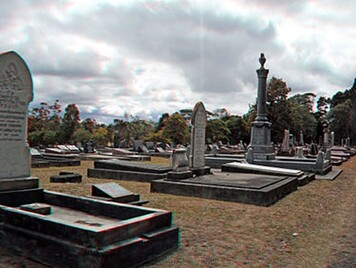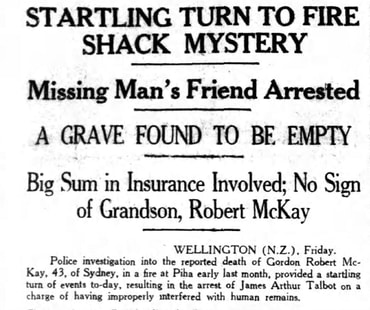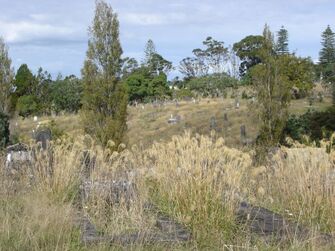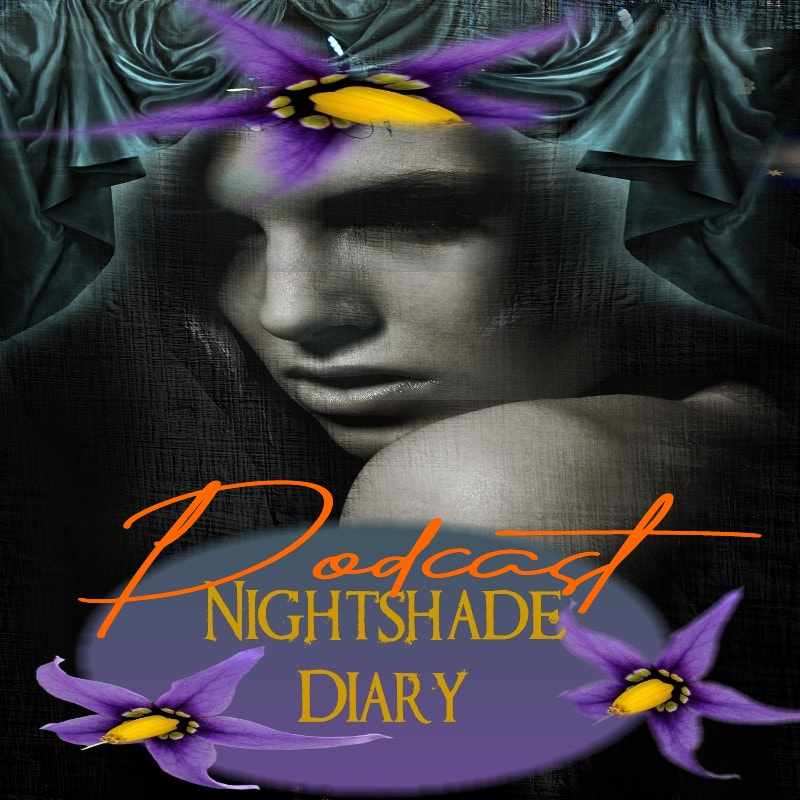
By M.P. Pellicer | Stranger Than Fiction Stories
Waikumete Cemetery is located in Auckland. It is the largest cemetery in New Zealand, and the second largest in the southern hemisphere. It covers almost 300 acres, and has over 70,000 burials. Is it little wonder that it has a fearsome reputation as being very haunted.  Drawings of Waikumete Cemetery in 1892 Drawings of Waikumete Cemetery in 1892
It was established in 1886, and the surrounding area grew around the hilly countryside it sits on. It replaced the Symonds Street Cemetery, which was the first official cemetery in Auckland in use from 1842.
A crematorium sits in the southwest corner of the cemetery, and the Chapel of Faith in the Oaks established in the same year, served as a mortuary chapel. It was in use until 1952 when a larger chapel was built. Two extensive areas of the cemetery were given over for burial of service personnel of the World Wars, and post-war veterans. Victims of the 1918 Spanish Influenza epidemic were buried there as well. And then there were those who sought to escape this mortal coil, by their own hand. On February 14, 1908, a little after sunrise, William Walker was passing through Albert Park when he noticed a man lying under a tree. When he investigated he found the man lying downward with a leather belt tied around his neck, and the ends of a broken rope attached to it. Nearby was a box, which he had used to hang himself. When the police arrived, the body was hardly cold. The man's name was Mate (Mati) Boksich, an Austrian of about 35 years of age. He was buried in the Catholic section of Waikumete Cemetery. He was a troubled man, who was arrested several times for beating women and officers who came to arrest him, when he was caught selling beer without a license. He was often referred for a mental examination by the judge. Samuel Slutzkin was 19 years old in 1905, when he took his own life by taking a poison known as phosphorus paste. He is buried in the Hebrew section of Waikumete Cemetery. Alfred Edwin Day, a 17-year-old left the home he shared with his family the evening of October 11, 1913. He had been very quiet, and his parents were hoping that after meeting his friends in Auckland he would return in better spirits. His friend Benjamin Smith knew the truth about why his friend was so down. He had been jilted by a girlfriend, and had threatened to take his life. He was later found at the beach barely alive, and he died at Auckland Hospital after taking a dose of poison that left his lips burned and blistered. He was buried at Waikumete Cemetery. In September of 1931, a Chinese fruit seller named Wing Tim Poy was found hanging in the cellar of a house located at 65 Gray's Avenue. He was only 40 years old and married, and had made arrangements to visit his family and wife in China. The health authorities did not allow him to leave as he was found to be suffering from leprosy. He left a suicide note, and was buried in the Public Burial Area A of Waikumete Cemetery. The cemetery became a favored spot where people would go to commit suicide. What was it that drew them there? Could it be the spiritual influence from those buried there that died by their own hand? In modern time, approximately a dozen suicides have taken place, some by hanging in the low-lying branches along the road, earning it the name of Suicide Lane.  A grave was robbed in Waikumete Cemetery as part of an insurance scam c.1939 A grave was robbed in Waikumete Cemetery as part of an insurance scam c.1939
In February 1939, the cemetery was involved in the first case of grave-robbing in New Zealand. Two Australian visitors to Auckland, Gordon Robert McKay and James Arthur Talbot, dug up the body of Patrick Henry Shine, a recently buried soldier, to use it in an insurance scam. They burned the body inside a shack at Piha. McKay was hoping to cash in on a £40,000 life insurance policy he took out on himself. An investigation by the insurance company discovered the fraud.
At one time murderers convicted to hang would be sent directly to Waikumete Cemetery, where they were executed and summarily buried in unmarked graves. Ghost gum trees were planted to indicate the area where they were interred, which is known as Murderers' Grove in the old section of the cemetery. This was also where paupers were buried as well. When the Spanish Influenza raged worldwide, New Zealand was not spared. Over 8,500 New Zealanders died—1128 were from Auckland. Many doctors, nurses and volunteers also became sick and died. The bodies were so numerous that at one point the hospital refused to accept them, and they were being shipped by train directly to a mortuary set up in the cemetery. These buildings would be marked with a white cross, and the bodies were buried in hastily opened trenches.  Older part of Waikumete Cemetery present day Older part of Waikumete Cemetery present day
Glen Eden Railway Station was the last stop before they would be taken over to the mortuary in the cemetery. The bodies would be stacked on the platform, and it not surprising that the station is also haunted.
There is one ghost in particular, which has been haunting the platform for the last 80 years. His name was Alexander George “Alec” McFarlane, and he had survived WWI and the Spanish flu. He was a railway porter and had immigrated from Scotland in 1913. The accident that ended his life took place on January 11, 1924. The railway station was in a different position. It was near the rear gates of Waikumete Cemetery, and had a loop track as well as the straight track past the station. The train was coming into the station, having already slowed down. Witnesses said that McFarlane had been walking towards the engine when he slipped, overbalanced and fell face down. The driver hit the brakes but it was too late, and the wheels rolled over MacFarlane's legs just above his knees. He was transported by carriage and ambulance to the hospital where he died two hours later. The 35-year-old was buried at Waikumete Cemetery two days later. His widow Jean joined him there in 1935. McFarlane's house was very close to the cemetery and the station. The driver of the train that hit McFarlane and the coroner at the inquest into his death are all buried at Waikumete Cemetery. Several sightings of a bearded man have been seen on the platform, even though McFarlane was clean shaven at the time of his death, and was known to always wear his porter's uniform. A cafe is now located at what used to be the railway station, and an employee described an odd looking man coming in with a top hat asking about the times the trains were running. She turned away for a moment, and he had disappeared. The following was posted in 2014 by a blogger: I’m not sure if this is any relevance, but my grandfather Marke Hemi was killed by a train at this exact location 1 year after they had moved it from its previous location. My grandfather was a heavy drinker, and on the 19th of July 2002 he was walking home from a long night at the local pub. His house at the time was situated on Brandon Road and it was alot quicker to cut along the tracks. We are still unsure how it happened. He may have stumbled or been involved in an altercation, and may have been thrown on to the tracks as back then Glen Eden had a problem with troubled youth or at worst it may have been a suicide. The train conductor told us before he was struck that his body lay strewn across the tracks, and he was thought to be rubbish bags until he got closer but it was too late. There was an article written in the old Sunday Star Times which featured a picture of my grandmother walking across the tracks.  Alec McFarlane, porter at the Glen Eden railway station c.1920s Alec McFarlane, porter at the Glen Eden railway station c.1920s
Another haunted location is the old chapel where 800 urns full of ashes were discovered when services were being moved to the new, larger chapel that had been built. Several people including a sexton have seen a cloaked woman believed to be a nun inside and outside the chapel.
Banging of doors, and sounds from the underground have been heard in different parts of the cemetery. The sound of bagpipes have been heard in the military section. Arthur Smith who used to work in the crematorium, said he had once seen a woman standing in the middle of the road. She had bare feet, and was wearing a long, white gown. Her hair was unkempt and she stared fixedly at him. He was getting ready to leave, and he recounts that he knew he had to get out of the area quickly and not meet her gaze. When he came to a gate that he had to open in order to exit, he looked from the corner of his eye, but she had disappeared. He never saw her again. In 2016, a blogger wrote a story about Waikumete Cemetery: Years ago around 2001 on a Thursday night after rugby practice I and some mates headed to our favorite spot in Glen Mall for a few drinks.. anyway it turned into a binge night and before you know it we are all smashed out of our rockers. Here's where it gets scary... I can't remember what happened after midnight. I came into conscience walking in Waikumete Cemetery not far from that chapel. As soon as I realized where I was stumbled to the road in horror running through the hedges cutting myself. I stood in front of the Jehova Witness Hall staring back at the cemetery trying to make sense of how I came to be in the cemetery while assessing the cuts I received from the hedges. I was still intoxicated and breathing heavily, but I could sense that whoever or whatever led me into the cemetery was still standing in that darkness staring back at me. Weeks after that I never mentioned anything to anyone, and quickly dismissed that night as one of my many drunken episodes, until a friend of mine said that his uncle (a bread delivery driver) overheard his work colleague tell how thy had almost run over a drunken male on Westcoast Road at 3am the same night, who was yelling at someone across the road. When I heard that, the hairs stood up on the back of my neck.
Source - Border Morning Mail
0 Comments
Your comment will be posted after it is approved.
Leave a Reply. |
Stranger Than Fiction StoriesM.P. PellicerAuthor, Narrator and Producer Archives
July 2024
Categories
All
|
Stories of the Supernatural
- Stories of the Supernatural
- Miami Ghost Chronicles
- M.P. Pellicer | Author
- Stranger Than Fiction Stories
- Eerie News
- Supernatural Storytime
-
Astrology Today
- Tarot
- Horoscope
- Zodiac
-
Haunted Places
- Animal Hauntings
- Belleview Biltmore Hotel
- Bobby Mackey's Honky Tonk
- Brookdale Lodge
- Chacachacare Island
- Coral Castle
- Drayton Hall Plantation
- Jonathan Dickinson State Park
- Kreischer Mansion
- Miami Biltmore Hotel
- Miami Forgotten Properties
- Myrtles Plantation
- Pinewood Cemetery
- Rolling Hills Asylum
- St. Ann's Retreat
- Stranahan Cromartie House
- The Devil Tree
- Trans-Allegheny Lunatic Asylum
- West Virginia Penitentiary
- Paranormal Podcasts
"When misguided public opinion honors what is despicable and despises what is honorable, punishes virtue and rewards vice, encourages what is harmful and discourages what is useful, applauds falsehood and smothers truth under indifference or insult, a nation turns its back on progress and can be restored only by the terrible lessons of catastrophe."
- Frederic Bastiat
- Frederic Bastiat

Copyright © 2009-2024 Eleventh Hour LLC. All Rights Reserved ®
DISCLAIMER
DISCLAIMER
 RSS Feed
RSS Feed
















